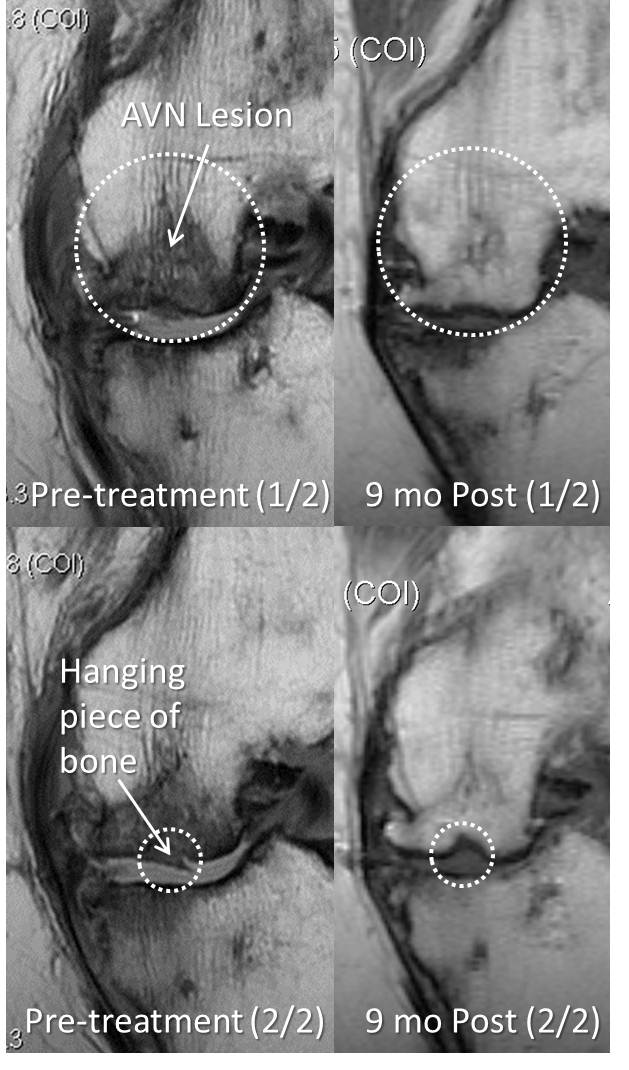Knee AVN (osteonecrosis) Helped with Stem Cell Injection
Knee avascular necrosis (AVN- also called osteonecrosis) is a dreaded disease where the bone begins to fall apart. It was once thought that this problem occurred due to bad blood supply to the bone (hence the name). While this may still be the case in some circumstances, AVN is likely more often caused by bone cells that are unable to keep up with the normal wear and tear that happens to all bones. This means that more bone cells die off due to normal use than can be replaced by new bone cells (mesenchymal stem cells differentiating to osteoblasts who then make new bone cells). So placing more stem cells in the AVN area to make more bone might help. This is the case of a woman in her 70’s who has had multiple knee surgeries and refused to give up and get a knee replacement due to concerns about complications. She was diagnosed with AVN of the knee and had this area watched with serial MRI’s for years. She had tried the latest and greatest technologies for her knees and wanted stem cells when they became available. As a result, she came to see us for the Regenexx-C procedure with injection of her own bone marrow stem cells into her medial femoral condyle of the knee (area of the AVN lesion). Above are the pre and post stem cell treatment MRI’s. (she lives on the east coast, see we were unable to get her imaged on the same machine). The left two MRI slices (1/2 and 2/2) are front views of the knee and the AVN lesion on the top left picture is encircled in the dashed line. It’s the dark color in the otherwise white bone. On the bottom right pre-treatment image, she has a fracture in the bone which is about to flake off. We felt it unlikely we would save this piece, so the treatment was focused on stopping the AVN above, as if left unchecked, the rest of that side of the knee bone would have continued to collapse. The after treatment pictures are on the right. The upper right picture shows normal bone signal in the dotted circle (no AVN lesion) and the lower right picture shows that the piece that was hanging on in the pre-treatment MRI has flaked off and been reabsorbed by the body. The summary is that the lesion has dramatically improved in this end-stage knee, due to an injection of the patients own stem cells under x-ray guidance into this bone AVN lesion. The radiologist’s impression is below. Has her pain changed in that knee? I spoke to her last night and she stated that it used be very swollen and painful all the time, but now the swelling is markedly down and the pain has significantly receded since the injection. The upshot? We’ve had good experience treating AVN lesions with using the patient’s own stem cells to treat certain lesions and stopping the progression of the AVN. There are a number of published reports on this technique, so others have confirmed that using the patient’s own bone marrow stem cells can halt the progression of this horrible disease. It should be noted that we don’t know the long-term outcome of the treatment yet, but in the 9 month time frame, things are going very well.

If you have questions or comments about this blog post, please email us at [email protected]
NOTE: This blog post provides general information to help the reader better understand regenerative medicine, musculoskeletal health, and related subjects. All content provided in this blog, website, or any linked materials, including text, graphics, images, patient profiles, outcomes, and information, are not intended and should not be considered or used as a substitute for medical advice, diagnosis, or treatment. Please always consult with a professional and certified healthcare provider to discuss if a treatment is right for you.

